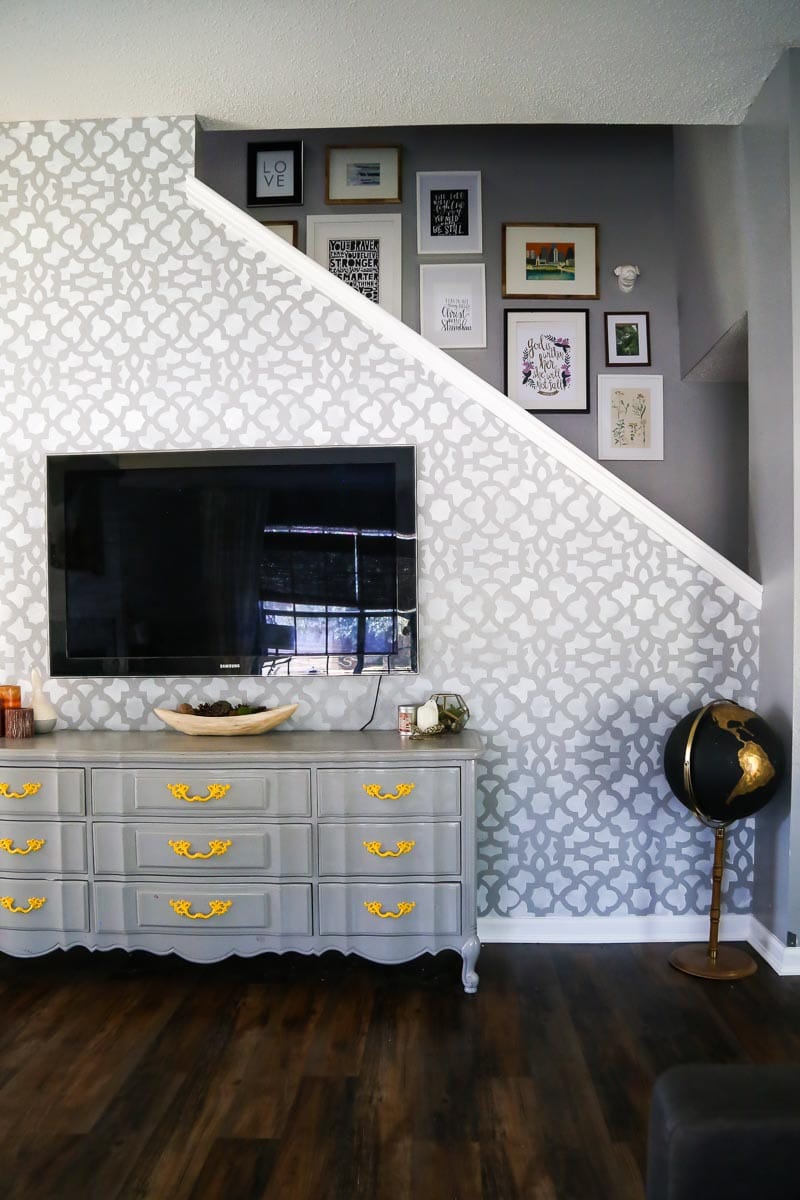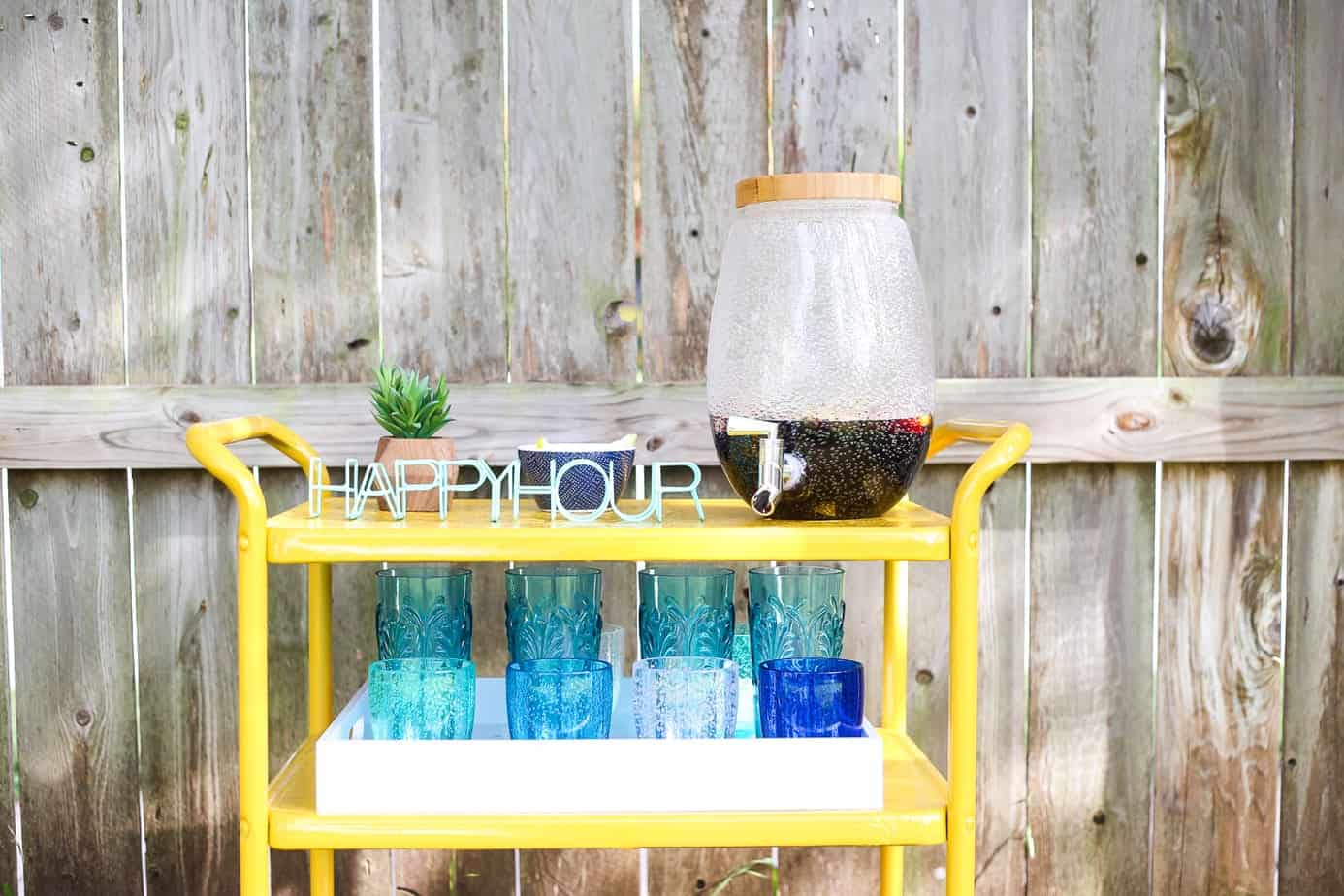How to Paint Furniture (Easy Tips & Tricks)
Here are my best tips for how to paint furniture. If you’re looking for some furniture painting tips to get you started, this is the post for you!
Friends, I’m sure if you’re anything like me, you have plenty of furniture in your house that functions just fine for your family but that you don’t love the look of. We’ve all got those not-so-pretty furniture pieces that we dream of someday replacing. But, we don’t always have the budget. Because of this, I have a lot of people who ask me how to paint furniture so that you can give it a quick makeover without spending a ton of money.
I’ve chatted about painting furniture many times before. It’s clearly a favorite here in our house.We’ve painted quite a few things over the years, so I’ll also link to the related post as I share photos!
How to Paint Furniture: Tips and Tricks

DIY Map Mural + Yellow Sideboard
Step One: Prepare Your Piece
You’re going to want to thoroughly clean and sand anything that you plan to paint before you get started. The level of prep work that’s required will vary a bit depending on what the original finish is. It it’s already painted, you’ll have a little more sanding to do than if it’s an unfinished piece. The thing to keep in mind here is that you don’t have to remove every single speck of the original finish. It’s perfectly fine to paint over old paint. However, you do want to make sure the surface is smooth and even.
If the original paint is chipped, you’re going to need to thoroughly sand the whole thing. You don’t want to end up with an uneven surface! But, if the original paint is in good condition, it’s fine to just sand the top coat down and paint over the existing finish. The bottom line is that when you start painting, you want the piece to be completely smooth And, you don’t want any super shiny finishes left on it (because they don’t accept paint well). I like this sander for a small piece that doesn’t need a ton of sanding. I like this one for a larger, more challenging piece.
Step Two: Prime
I’ll admit – sometimes I get lazy and skip this step. But, it really isn’t one that should be skipped (even if you’re using self-priming paint!). Primer provides a base layer for your paint to stick to. It also makes the finished product more durable and helps ensure your color will stay true. Even though I’m a huge fan of my paint sprayer, I typically use a roller or a brush when I’m priming. It’s thicker than normal paint and can be difficult to use with a sprayer. I like to use this paintbrush and this primer. When I’m rolling, I tend to stick to these roller covers.

Step Three: Paint
Now comes the fun part! It’s time to paint. I basically always use a paint sprayer when I’m painting furniture. It gives you the smoothest finish, it’s much faster than anything else, and it really is just the best way to give you a good end result. The exact directions will vary depending on the paint sprayer you’re using. But, it’s a much simpler process than you might expect. Just pour the paint into the appropriate container, pull the trigger, and get to it.
A few quick paint sprayer tips: you’re going to want to hold the sprayer closer to the piece than feels comfortable – no more than a foot away. I typically shoot for about 6-8 inches. Move slowly and steadily, and try to move the sprayer all the way off the piece on either end as you move back and forth. If you switch directions while spraying the piece itself, you can end up with too much paint in on section. I generally recommend two coats of paint for most pieces. If you want an ultra-smooth finish, you should lightly sand between each coat with a super fine-grit sandpaper. This is my go-to paint sprayer, but if you’re just getting started and feel a bit nervous about using one, this is a great starter sprayer!
Step Four: Finish
This is one of the most important steps of the entire process. It’s what protects your furniture from dings and scratches, makes it easier to clean, and just generally makes everything a lot more durable. You’ll want to follow the recommendations on the finish that you choose. You have a few different options depending on what you’re going for.
A polyurethane or polycrylic is generally universally safe for any project or piece of furniture and it’s what I reach for most often. You could also use lacquer if you want a thicker, shinier finish. It’s much smellier, so just keep that in mind! Or, you can even use something as simple as a finishing oil if you’ve stained the piece instead of painting it. No matter what you choose, be sure to read the directions on the can. Most recommend a soft-bristled brush to apply the finish. And, most require 2-3 coats, with several hours of dry-time in-between. Oh, and one more note: be sure to allow your paint to dry fully before applying your finish. Most paints recommend around 4 hours of dry time, but I like to shoot for 12-24 hours whenever possible.

Step Five: Allow to Cure
If you want to be sure that your piece will stand the test of time, be sure to allow it to cure completely before you bring it back into your space. It’s a little-known fact that most paint takes about 30 days to fully cure. That means it’s not going to reach it’s maximum hardness until about a month after you’re done painting! Of course, that doesn’t mean you need to wait a month before you can use your piece – but I would recommend waiting a solid 24 hours or so before bringing the piece back into the room, and we generally try to be cautious with the piece for the first week or so, to give the paint as much time as possible to harden.
And that, my friends, is how you paint a piece of furniture.

I know it can seem like an intimidating process if you’ve never done it before, but I promise you it’s simple! My recommendation is to start with something cheap and easy to replace (maybe see if you can snag something cute from a garage sale or your local thrift store), so that you aren’t heartbroken if things go awry. Once you’ve built up a bit of confidence in your furniture painting skills, you can move on to more complex or important pieces – and before you know it, you just might be eyeing every piece of furniture in your home and brainstorming what color you want to paint it!

Hey Amanda,
I liked that step 2 intro:”Sometimes I’m lazy and skip this step” lol … me too.
Now, seriously, I am in the construction industry. I work as a pro and do DIY as well … but something that I’m not that good is at painting.
I believe it’s because there are some many little steps to do and the waiting time between those little steps is what kills me:)
But this is a good tip post. I enjoyed reading it. I hope next time I paint I have the patience to apply these steps to my process 🙂
Thanks for sharing.
Adrian at ninjaDIY
I love painting old furniture and giving it a fresh new look. Thanks for sharing at #HomeMattersParty
I need to get more daring with trying to paint. #homematters
Wow! You’re definitely a pro at this! I’m just curious though, have you ever had the poly top coat turn yellow? I painted a dresser white and the poly turned yellow on me :(….. what did I do wrong?
Hey Karrie! Yes, I’ve definitely had that happen – it’s so frustrating! Really, it just depends on the top coat that you’re using – some are more likely to yellow than others. We’ve had really good luck with Minwax’s Polycrylic, and I’ve heard Rust-Oleum’s Crystal Clear poly is really good for avoiding yellowing too!
This yellow piece looks amazing in contrast to the dark wall, love it!
Thank you!
Amanda – you have so many gorgeous furniture makeovers. We love the gray living room dresser with beautiful yellow handles. You give such great tips and advice for spray painting – we need to try that more!
Thanks so much!!
I have always loved your yellow dresser! It is stunning. Great tips!
Thanks, Amy!
There are so many great pieces in this post, Amanda! I’m SO glad you talked about the time it takes for the paint to cure on a piece of furniture. You are totally right – the drying and curing time makes a HUGE difference in how long the finish will last. As always great advice! Hugs, CoCo
Thanks, CoCo! And yes, the curing time is vital!
I love all of your tips and that yellow piece is STUNNING! What a show-stopper! Just amazing!
Thanks so much, Lindsay!